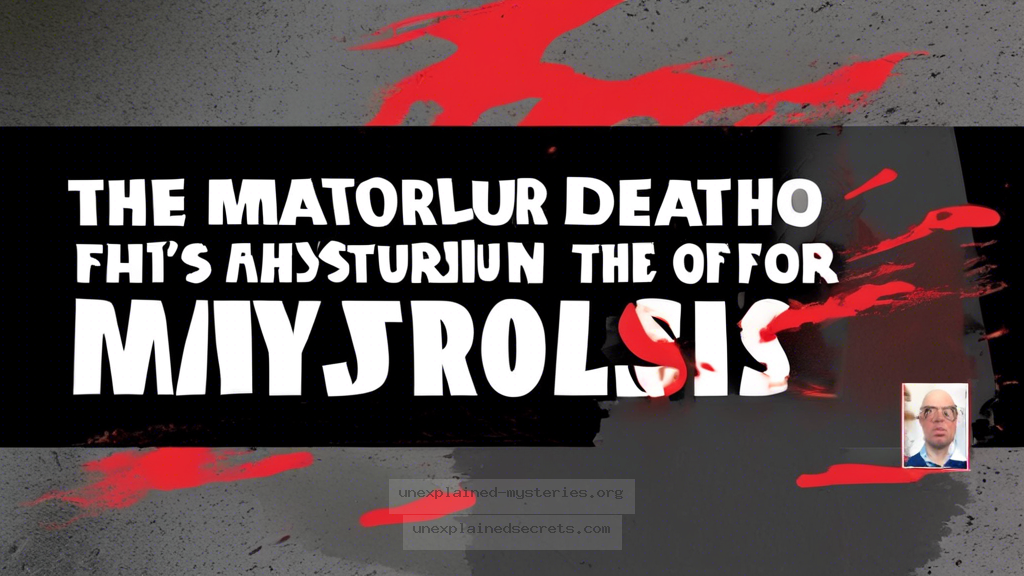What Secrets Lie Behind the Mysterious Death of Journalist Danny Casolaro?
What Secrets Lie Behind the Mysterious Death of Journalist Danny Casolaro?
The mysterious death of journalist Danny Casolaro in 1991 has long been a focal point for conspiracy theorists and investigative journalists alike. His death is often referred to as a “suicide” by official accounts, but the circumstances surrounding it raise numerous questions that have yet to be answered. Why does this case resonate so deeply, and what does it reveal about the intersection of journalism, government, and hidden agendas? In this blog post, we will explore the enigmatic details of Casolaro’s life and death, the theories that emerged, and the implications of this unsolved mystery.
Who Was Danny Casolaro?
Born on January 21, 1947, in New York City, Danny Casolaro was a freelance investigative journalist with a penchant for uncovering corruption. He had previously worked for various publications and was known for his relentless pursuit of truth, particularly in connection with the alleged criminal activities of powerful entities. His investigations often intersected with government contracts, intelligence agencies, and corporate malfeasance, which would ultimately lead him into dangerous territory.
Casolaro’s most significant project involved the investigation of what he termed the “Octopus,” a term he used to describe an intricate web of corruption involving the U.S. government, intelligence agencies, and private corporations. He believed that these entities were involved in illicit activities, including drug trafficking and arms deals, linking back to the Iran-Contra scandal. This perception of a vast conspiracy would set the stage for his tragic demise.
The Circumstances of His Death
On August 10, 1991, Danny Casolaro was found dead in a hotel bathtub in Martinsburg, West Virginia. The official ruling was that he had committed suicide by slashing his wrists, but several factors surrounding his death have led many to question this conclusion. Notably, there were no defensive wounds on his body, and the nature of the cuts suggested a level of precision that seemed inconsistent with suicide. Additionally, Casolaro had expressed concerns for his safety prior to his death, telling friends he feared for his life.
Key Factors in Casolaro’s Death:
- No defensive wounds found on his body.
- Concerns for personal safety expressed prior to death.
- Discrepancies in the official police report.
The “Octopus” and Its Implications
The term “Octopus,” as coined by Casolaro, refers to a complex network of corruption that he believed intertwined various elements of government and private enterprise. His investigation suggested that this network was involved in illicit activities including drug trafficking, arms smuggling, and perhaps even political assassinations. This theory is not without precedent; many cases throughout history have illustrated how government and corporate interests can collide, sometimes leading to dire consequences for those who dare to expose the truth.
Casolaro had compiled extensive notes and documents related to his investigation, which he intended to use to reveal the “Octopus” to the public. However, after his death, these materials disappeared, leading many to believe that his findings posed a threat to powerful interests that would go to great lengths to keep such information from being disclosed.
Investigating the Conspiracy Theories
In the wake of Casolaro’s death, numerous conspiracy theories emerged. Some of the most prominent theories suggest that Casolaro was murdered due to his investigations into the “Octopus.” Others speculate that he was the victim of a cover-up orchestrated by government entities to silence him. The lack of clarity surrounding the circumstances of his death has fueled speculation and debate, leading to further investigation by journalists and amateur sleuths alike.
Notable investigative works, including books and documentaries, have explored the various angles of Casolaro’s story. Many of these works delve into his connections with other mysterious deaths and unsolved cases, suggesting a broader pattern of silencing dissenting voices.
Historical Context: Government Secrecy and Cover-ups
The case of Danny Casolaro exists within a broader context of government secrecy and cover-ups in the United States. Over the decades, numerous instances have demonstrated a willingness on the part of government agencies to engage in morally questionable activities to protect their interests or conceal their actions. The Iran-Contra scandal, Watergate, and other high-profile political scandals have highlighted the lengths to which those in power will go to maintain control over information.
This historical backdrop adds weight to the theories surrounding Casolaro’s death, as it serves as a reminder that journalists who challenge authority often face significant risks. The notion that Casolaro may have stumbled onto something far more dangerous than he anticipated makes his story not just a personal tragedy, but a cautionary tale about the perils of investigative journalism.
Common Misconceptions About the Case
One of the most prevalent misconceptions about Danny Casolaro’s death is that it was definitively ruled a suicide without any room for doubt. While the official narrative tends to support this conclusion, numerous investigative journalists and scholars have pointed to the inconsistencies in the evidence and the circumstances leading up to his death. This narrative oversimplifies a complex situation and serves to dismiss legitimate concerns about the possibility of foul play.
Another common misconception is that Casolaro was a lone wolf, acting independently without any support or connections. In reality, he was part of a broader network of journalists and activists who sought to expose corruption. His connections with other whistleblowers, journalists, and investigators may have provided him with critical insights but also placed him in greater danger.
Alternative Perspectives on the Investigation
While the mainstream narrative often suggests that Danny Casolaro’s death was a tragic suicide, alternative perspectives exist that challenge this conclusion. Some theorists argue that Casolaro’s death was a calculated act of murder, orchestrated by those who felt threatened by his investigation. Others posit that he may have encountered a situation that spiraled out of control, leading to an accidental death that was then covered up.
Investigative journalist and author, who have delved into this case, often highlight the discrepancies in the police reports and the lack of thorough investigation into the circumstances surrounding Casolaro’s death. Many believe that a more rigorous inquiry could yield critical insights into what transpired and potentially identify those responsible for any wrongdoing.
How to Investigate Similar Cases
The case of Danny Casolaro serves as a reminder of the importance of thorough investigation and critical thinking when faced with mysterious circumstances. For those interested in exploring similar cases or delving deeper into the world of investigative journalism, consider the following best practices:
- Verify Sources: Always check the credibility of sources before accepting information as fact.
- Seek Multiple Perspectives: Understand that there may be multiple sides to every story, and consider alternative viewpoints.
- Stay Informed: Keep abreast of developments in related cases and broader issues of government transparency and accountability.
- Network with Others: Connect with journalists, researchers, and activists who share similar interests in uncovering the truth.
- Document Findings: Keep detailed records of your research and findings to ensure accuracy and accountability.
Ongoing Research and Future Developments
The case of Danny Casolaro continues to inspire researchers and journalists who seek to understand the dynamics of power and corruption. Ongoing research into government transparency, whistleblower protections, and the implications of investigative journalism will be critical in shaping the future landscape of this field. Documentaries, podcasts, and books about Casolaro and his investigations have gained renewed interest, suggesting that the public still craves truth and accountability.
As more individuals and organizations advocate for transparency and ethical governance, it is possible that the case of Casolaro may receive the renewed scrutiny it deserves. This could pave the way for greater understanding of the forces at play in cases of corruption and cover-ups, and perhaps even lead to justice for those who have been silenced.
Conclusion: The Legacy of Danny Casolaro
The mysterious death of Danny Casolaro serves as a poignant reminder of the risks faced by those who pursue the truth. His story encapsulates the complex interplay between journalism, government, and corporate interests, raising essential questions about accountability and transparency. While the official narrative suggests suicide, the numerous inconsistencies and unanswered questions leave room for doubt and further investigation.
As we reflect on Casolaro’s legacy, it is crucial to advocate for greater transparency and insist on accountability from those in power. The fight for truth continues, and the lessons learned from this case can inspire future generations of journalists and activists to pursue justice, no matter the cost. Ultimately, the story of Danny Casolaro underscores the importance of vigilance and the pursuit of truth in the face of overwhelming opposition.
Other Articles
What Really Happened During the 1976 Tehran UFO Incident?
Recent Posts
- What Happened to Flight MH370? The Conspiracy Theories That Still Haunt Us
- What Secrets Lurk Within the Walls of the Infamous Trans-Allegheny Lunatic Asylum?
- What Evidence Supports the Existence of Bigfoot in the Pacific Northwest?
- What Happened to the Indus Valley Civilization? Unraveling the Mysteries of Ancient Urban Life
- Can Telepathy Be Scientifically Proven Through Laboratory Evidence?







